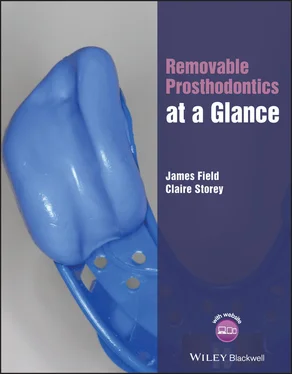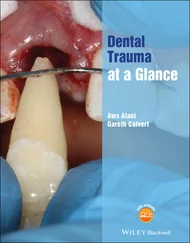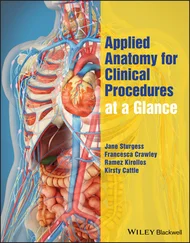Effective communication takes time . As clinicians we often start looking for mechanical reasons to explain why patients might be having difficulties with their existing prostheses – excessive movement, trauma or ulceration, poor retention, or design of coverage. On that basis, we often agree to make a new prosthesis. In reality, patient tolerance relates to very much more than just mechanics and physical function. It is crucial that the treatment you provide is driven by patient-perceived need . This means that patients need to understand and buy into the clinical rationale, including risks and benefits, of the proposed treatment. Similarly, we need to understand the patient's rationale for wanting a prosthesis. Given enough time, it is highly likely that these requirements can be met.
Often, the process of making removable prostheses begins with a primary impression. Try and break that habit, and implement these simple steps first:
1 Set aside at least 5 minutes to talk to your patient
2 Sit in front of your patient – do not stand in front of your patient with a stock tray in your hand!
3 Invite your patient to explain why they would like you to make a denture – what are they hoping it will provide?
Crucially, your patient needs to feel that they can talk freely and comfortably about their tooth loss. This will not happen if they feel rushed, or feel that you are not actively listening to them.
This incredibly important part of the process is investigative . It should determine the choice of treatment that will follow. If the patient has an existing prosthesis, ensure that you ask what they think might change with a new one? What would they like to change?
It is at this early stage that you can begin to modify your patient's expectations if you feel that they are unrealistic. It is always better to begin this way, than back-tracking later and trying to reduce high expectations at the try-in or the fitting stages.
It is also a good opportunity to provide your honest thoughts on the likely outcome. We would caution against promising patients that their new prosthesis will be any better than the one that is being replaced, even if you can identify significant technical flaws. Instead, it is beneficial to ensure that you:
Reiterate why you think the patient would like a new prosthesis
Describe any technical features that you believe you can improve upon
Estimate how many visits, including retries and review appointments, you expect may be needed
Explain the fact that when the new prosthesis is fitted, even if it is technically better, it will still take a period of acclimatisation (up to 6 months, and longer in some cases) before the patient is able to function optimally
Generate an understanding that during this time, the patient will need to adapt slowly to their new prosthesis, even if it appears to function comfortably – and this is particularly important in relation to complete denture patients
Communication aside, the process of making removable prostheses is more manageable than it may seem at first. There are often simple approaches that can yield excellent results, without expensive materials or equipment. In the main, technical success is about attention to detail and knowing which materials work best in your hands.
The aim of this at-a-glance guide is to provide advice on how to achieve optimal outcomes at each clinical stage of the process. Our opinions are based on decades of combined experience teaching at undergraduate and postgraduate level, and routinely treating a wide range of cases. We have provided recommended reading for each chapter in case you wish to read more about the technical stages, or to understand better the theory and evidence base that underpins the fabrication of removable prostheses.
Educationally, we use the term ‘bricolage’ (tinkering) when we are teaching our students about new materials in the clinics. If it has been a while since you have used some of the materials in this book, then get hold of some of them, and have a play!
2 The function of removable prostheses

It is often assumed that the function of a prosthesis relates only to ‘mastication’ – but there are many other functions that removable prostheses can serve. As clinicians, we are often good at recognising technical reasons why dentures should be constructed – but often the social aspects from the patient's perspective are overlooked.
Be mindful that the prosthesis must serve a function as perceived by the patient. If we are constructing a prosthesis that has a clear clinical rationale, but the reasons are less obvious to the patient, then we must spend time explaining how we intend the prosthesis to help. Unless the patient understands and believes the rationale for their construction, they are unlikely to wear them regularly.
That said, it is remarkable what patients will tolerate in order to achieve a desired outcome. For example, a patient might wear their prostheses whilst they are out of the house in order to facilitate a more normal social life – even if it is painful – but it is likely that they will take them out once they enter the house again – especially if they live alone. This is probably not dissimilar to us kicking off a pair of shoes that have been rubbing – but made us look good. Many patients living alone also take their dentures out in order to eat – so do not always think that the primary function of your lovingly constructed dentures is to help your patient to chew!
It is important to remember that replacement of all of the patient's missing teeth is often unnecessary. That said, it is still critically important that denture bases are extended into the full denture-bearing area in order to maximise stability and retention – and this will be discussed further in the following chapters.
Removable prostheses are indicated primarily for the following clinical reasons (Figure 2.1):
Restoring masticatory function
Restoring appearance
Restoring speech
Restoring soft tissue bulk and providing soft tissue support
Acclimatisation during the transition to becoming edentulous
Removable prostheses are often indicated for the following technical reasons:
Restoring long edentulous saddles
Restoring multiple short edentulous saddles
Providing posterior stability and improving occlusal load distribution
Preventing undesirable tooth movements
Rehabilitating to an increased vertical dimension
Facilitating functional anterior guidance
In order to prescribe diastemata between prosthetic teeth
To avoid preparing abutment teeth for fixed prostheses
To avoid cantilevering from root-treated teeth
To aid planning and diagnosis, especially prior to implant placement
Finally, but by no means least, our patients may well request removable prostheses in order to:
Improve aesthetics
Restore social confidence
Improve their eating experience
Notice that most of the clinical rationale is based around restoring or rehabilitating , whilst patient requests often centre around improving . This important subtlety can easily be lost when negotiating informed consent. Correcting technical deficiencies and restoring clinical function does not necessarily result in a patient-perceived improvement. Again, moderating patient expectations is critical at each stage of treatment.
Читать дальше













